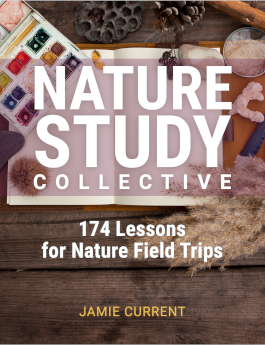Nature Study Collective: 174 Lessons for Nature Field Trips is a guide for nature study in keeping with Charlotte Mason’s methodology, but it provides more structure than many other nature-study guides. This guide can be used with students from prekindergarten through high school.
You can purchase print or digital editions. The printed book is 6” by 9” and has 204 pages. When you purchase the digital edition, you receive a PDF book as well as an ebook file that will resize for use on mobile devices. You can also buy both print and digital editions together from the publisher at a significant discount.
The guide covers 14 science topics, such as birds, fish and amphibians, insects and spiders, stars and sky, reptiles and amphibians, and weather and climate. Each topic has seven to twenty lessons, and some lessons should be repeated. For instance, the topic of birds has 11 lessons, but it also has a “Study 12” activity that directs students to become familiar with 12 different types of birds in their area, creating a journal entry for each one. Observations of each bird will constitute a lesson, adding another 12 lessons to the topic. Using one lesson per week, you will have far more lessons than you can complete in one year.
The guide was written for those living in North America, but most of the activities will work anywhere as long as you have access to nature where you can observe plants, animals, insects, birds, and other life forms. The lessons can be used in whatever order you wish or according to your seasons and are ideal for families and co-op groups.
True to its title, the guide prompts frequent field trips to settings appropriate for nature study. Very brief introductions lead into the 14 topic sections, and it occasionally has brief information at the beginning of a lesson. You will usually read this information aloud to your children. You might also do some preliminary reading on a topic from the suggested resource books before setting off on a field trip, or you might find that the recommended books are more useful after field trips. There’s a lot of flexibility which should be great for parents and teachers who like to structure their lessons themselves.
On your field trips, you will want to bring along either printed field guides or an app that helps with the identification of living things. Each section in the guide has recommendations for field guides and apps if they are available for that topic. You will also carry along student journals (blank notebooks), writing and drawing implements, and art media such as colored pencils and watercolors. (You might save the coloring or painting to be done indoors.) Sometimes, you might want to bring along other resources such as a travel microscope or a lidded jar with holes poked in the lid, and the guide alerts you when such items might be needed.
Children will learn to observe and pay attention to details, recording their observations in a journal—an important aspect of the nature field trips. Parents can write for younger children if they need help. The guide’s author, Jamie Current, says on page 11:
As they encounter and study nature, they must mentally sort through their findings to choose how to record them in a nature journal. The pages are blank. Students fill them with drawings, written notes, diagrams, and measurements, as they determine. This process ensures that they truly understand the subject and gives them practice ordering their thoughts as they consider transmitting the information to others.
Some lessons will stretch over many days or weeks, such as the lesson that has you construct a birdhouse together and document its use over several weeks or the lesson that involves planting tree seeds and watching them sprout. Some lessons might more easily be done at home, such as dissecting an abandoned bird’s nest and creating detailed, labeled drawings of collected items. Some lessons must be done indoors, such as the experiment to demonstrate the water cycle and the lesson that involves researching safe and dangerous snakes in your area.
Some activities might not be possible or practical to do as directed. You might not be able to witness a meteor shower or spot a shooting star for the “Shooting Stars Watch” lesson, but perhaps you could search online for film footage to view instead. If you don’t live in an area where it snows, you probably won’t be able to view snowflakes or measure snowfall. Even if you skip a few activities, there are more than enough that will be accessible to most families.
In case you are looking for more options beyond the lessons, a section near the end of the book, titled “Observing Anything,” offers even more suggestions for observations, games, and activities, and the following section, titled “Trail Activities,” suggests an even broader collection of things you might try, such as night hikes and collecting items that represent the colors of a rainbow.
The printable "Nature Study Plan" form in the book as well as on the publisher’s website should be helpful for both planning and recordkeeping.
There are a few references to God in the book but none within the lesson material. So, Nature Study Collective can be used by families with various religious viewpoints.
Summary
Children can have a great time learning about nature through the activities in Nature Study Collective. More important from an educational standpoint is that nature study is useful for teaching children about the world of living things through their senses as they learn to be attentive and accurate in their observations. It also provides a foundation for scientific learning as they learn to record, categorize, and analyze the information they collect. This guide provides parents and teachers with a structured way to help children develop these skills.









